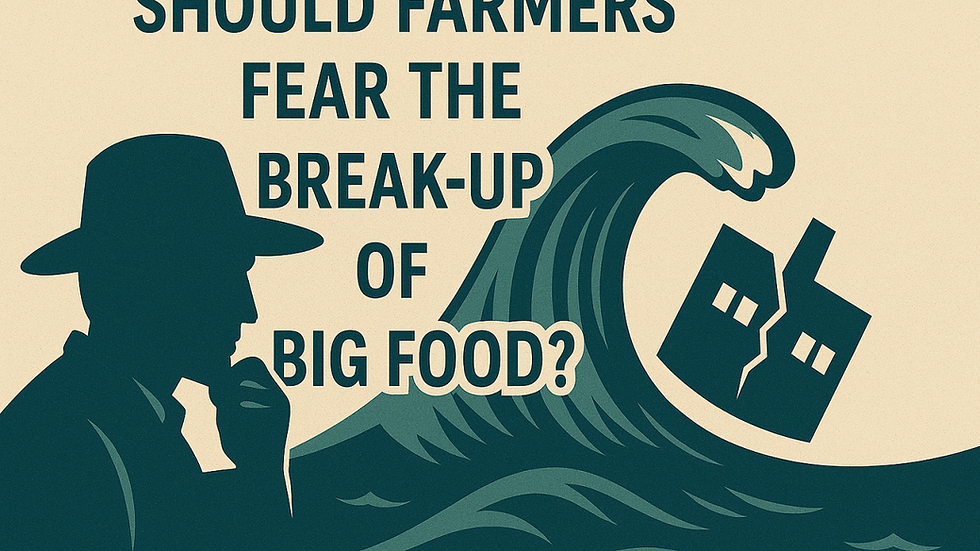Destination Time to a Meal: 1,500 Miles Across Global Waterways
- Michelle Marshall

- Apr 2, 2024
- 3 min read
By Michelle Pelletier Marshall, Women in Agribusiness Media (April 2, 2024)
One may not think too often about just how far our food has come to be on our dinner plate. But considering the recent bridge collapse of the Francis Scott Key Bridge in Baltimore, Maryland, this has come to the forefront due to all waterway vessel traffic being suspended indefinitely at that Port – the Port of Baltimore.

The tragedy has seen lives lost and some still unaccounted for, and livelihoods shifted – some 2,400 dockworkers and International Longshoremen's Association (ILA) members are left with uncertainty about their jobs. Additionally, the whole disaster is now blocking one of the country's busiest ports for ag commodities and other products.
The U.S. inland waterway system is a labyrinth of locks and dams traveling upon the upper and lower Mississippi River, Arkansas River, Illinois and Ohio Rivers, Tennessee River, and the Gulf Intracoastal Waterway. It is a most efficient, economical mode for transporting agricultural products to the nation’s export terminals. Disruptions along this barge supply chain – which on the Mississippi River alone account for 92 percent of U.S. agricultural exports, or an estimated 589 million tons of freight with an estimated value of more than $405 billion annually, according to an Arkansas Farm Bureau Ag Insider report – have a ripple effect across the ag supply chain.
The Port of Baltimore ranks 17th in terms of cargo throughput in the United States, processing more than 37 million short tons of combined import and export product in 2021. According to the American Farm Bureau Federation (AFBF), the port is responsible for moving 0.3 percent of U.S. ag exports and 2.1 percent of imports, and in 2023, the port exported 605,000 tons of agricultural products.
Luckily, this port’s standing, coupled with new supply chain solutions and flexibility initiated to counter the inadequacies exposed during the pandemic, mean that producers and agribusinesses will be better able to mitigate potential impacts in business operations from this disruption in ag commodity exports at the Port of Baltimore.
Waterways Abroad
Traveling beyond U.S. ports, interruptions on the waterways at the Panama Canal and in the Red Sea at the Suez Canal are occurring due to the recent environmental and geopolitical crises – the worst drought in history at the Panama Canal, and heightened military tensions in the Red Sea at the Suez Canal due to the Israel–Hamas war. Just last week, Russian warships entered the Red Sea, bringing the crisis there to near boiling point.
At the Panama Canal there have been significant reductions in daily transits, down from 36 to 40 per day to 24 daily transits, and a rerouting of a lot of ag exports headed to Asia from New Orleans to the longer and more expensive route via the Cape of Good Hope, around the southern tip of Africa, explained Mike Steenhoek, executive director of the Soy Transportation Coalition, to Missouri Farmer Today.

Steenhoek explained that because the Panama Canal is not a sea level canal and instead utilizes locks, the operation of the canal is a function of the available precipitation that occurs to fill Gatun Lake, the reservoir that feeds fresh water to the canal locks, so less rain means draft width restrictions and less traffic through the canal.
Meanwhile at the Suez Canal, threat of Houthi pirates hastens water travel there, with many cargo vessels rerouting around the Cape of Good Hope, which adds up to 3,500 nautical miles and four weeks to product delivery dates to the typical trip between Europe and Asia.
Overall, the global waterway ag supply chain is resilient, and expected to continue to support the global agriculture market, which is projected to be US$3.90 trillion in 2024 with an annual growth rate of 5.66 percent. And know that, when you sit down to dinner, the food on your plate likely traveled 1,500 miles before it got to you – many more miles than the average person walks in an entire year (1,182 miles).
- Michelle Pelletier Marshall is contributing editor and author for HighQuest Partners’ GAI News, and managing editor for its WIA Today blog. Additionally, she is the company’s Senior PR/Media Manager. She can be reached at marshall@highquestpartners.com.








